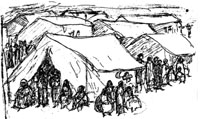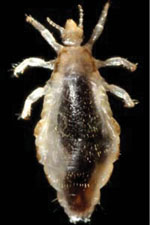36.1 The human body louse
Before we discuss relapsing fever and typhus, it is first helpful to describe the vector of both these diseases. The human body louse (species name, Pediculus humanus humanus) is commonly found in the clothes, bedding and on the bodies of people living in overcrowded and insanitary conditions, where there is poor personal hygiene. When body lice are found, for example in clothes, the articles are said to be louse-infested. (Note the term is infested, not infected.)
Can you suggest examples of places where louse infestation is more likely to occur because of overcrowding and lack of sanitation?
You may have suggested refugee camps (Figure 36.1), badly maintained prisons or army camps during times of war.
 Figure 36.1 Overcrowding and poor sanitation create perfect breeding sites for body lice.
Figure 36.1 Overcrowding and poor sanitation create perfect breeding sites for body lice.
Male and female lice mate and the female lays eggs (known as nits), which she attaches to body hairs or fibres in clothing and bedclothes where people sleep (Figure 36.2). The eggs hatch into small immature lice (called nymphs), which bite their human hosts to suck blood, nourishing their growth and development into adult lice (Figure 36.3). They have a lifespan of only a few weeks, and feed at frequent intervals. The bites cause an allergic reaction in the person’s skin, which becomes inflamed and itches, causing the person to scratch the area. Lice are transmitted from person to person during close contact and when sharing bedding in which eggs have been laid. They can survive for only a few days off the human host.


Although human body lice can transmit relapsing fever and typhus, the modes of transmission are somewhat different in these two diseases, as you will see in the following sections.
Learning Outcomes for Study Session 36
